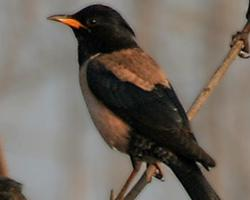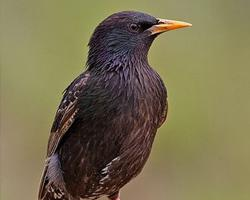
Statut de conservation
| Menacé |
Description de l'animal
The Rosy Starling, scientifically known as Pastor roseus, is a captivating bird species that belongs to the starling family, Sturnidae. This medium-sized passerine bird is particularly known for its striking plumage and remarkable migratory patterns, making it a subject of interest among birdwatchers and ornithologists alike.Adult Rosy Starlings exhibit a distinctive appearance that sets them apart from other starlings. During the breeding season, which occurs in late spring and summer, males boast a brilliant rosy-pink body contrasted with a jet-black head, wings, and tail. The combination of these colors gives the bird an elegant and striking look. Females and non-breeding males are less colorful but still maintain a hint of the rosy flush that gives the species its name. Juveniles are predominantly grey-brown and acquire the adult plumage after their first winter.
One of the most fascinating aspects of the Rosy Starling is its migratory behavior. These birds breed across a broad swath of the temperate regions of Central Asia, from the easternmost parts of Europe across to Mongolia and northwestern China. They prefer open landscapes, often near human habitation, where they can find grasslands or semi-deserts to breed. When the breeding season concludes in late summer or early autumn, Rosy Starlings undertake a long migration to their wintering grounds in the Indian subcontinent. This journey is remarkable for the large flocks that the birds form, sometimes numbering in the thousands, creating spectacular displays in the sky.
The diet of the Rosy Starling primarily consists of insects, making it a beneficial species for agriculture by controlling pest populations. During the breeding season, they feed extensively on locusts and other crop-damaging insects, making them welcomed visitors in their breeding range. In their wintering grounds, their diet shifts to include fruits and seeds, showcasing the bird's adaptability to different food sources based on availability.
Rosy Starlings are social birds, not only during migration but also in their breeding and feeding habits. They nest in colonies that can be quite large, with nests built close to each other in trees, cliffs, or even on buildings. These colonies are noisy and lively places, with constant communication among the birds. The social structure of the colonies helps in protecting against predators and increases the efficiency of finding food.
Conservation status of the Rosy Starling is currently listed as Least Concern by the International Union for Conservation of Nature (IUCN), indicating that, for now, the species does not face immediate threats of extinction. However, habitat loss and changes in agricultural practices could potentially impact their numbers. Conservation efforts and monitoring are essential to ensure that this beautiful and beneficial bird continues to thrive across its extensive range.
In summary, the Rosy Starling is a bird of great beauty and ecological importance. Its vibrant plumage, fascinating migratory patterns, and social behaviors make it a remarkable species. As it navigates vast distances between its breeding and wintering grounds, it connects continents and cultures, reminding us of the interconnectedness of our world's ecosystems.
Animaux similaires
Nouvelles photos d'animaux
Top 10 des animaux
- Dolphin gull (Leucophaeus scoresbii)
- Japanese macaque (Macaca fuscata)
- Stone loach (Barbatula barbatula)
- Greek tortoise (Testudo graeca)
- Russian tortoise (Testudo horsfieldii)
- Galápagos tortoise (Geochelone nigra complex)
- Diana monkey (Cercopithecus diana)
- Moustached guenon (Cercopithecus cephus)
- Common flying dragon (Draco volans)
- Galápagos penguin (Spheniscus mendiculus)


